I now want to tell you what I know about John’s ancestry — which is, to be candid, absolutely nothing certain. I have not found proof of John Green’s parents. It’s clear to me that he was born in the Long Cane settlement of what would by 1785 become Abbeville County, South Carolina. The posting linked above and the chain of postings following it provide my reasons for concluding that John Green was born there, where we know from multiple sources his wife Jane Kerr, daughter of early Long Cane settlers Samuel Kerr and Mary Calhoun, was also born — as her tombstone states and as other sources also cited in the thread of postings following from the linked posting tell us.
So the search for John Green’s parents points me to the Long Cane settlement of what would become Abbeville County, South Carolina, where there’s abundant documentation in different sources of the arrival and settlement there of Jane’s Calhoun, Kerr, and Pickens ancestors. Much of that documentation comes from records outside Abbeville County records themselves. Anyone with early ancestors in what became Abbeville County who has to rely on early Abbeville records for information faces a serious hurdle for the following reason explained in FamilySearch’s wiki page for this county: “Fires in January and November of 1872 and January 1873 destroyed virtually all records except those of the probate and equity courts.”
In the case of John Green’s parents, that hurdle has so far proven insurmountable. Due to the loss of the early records of Abbeville County, I have not been able to locate a single record in which anyone living by the 1760s in the area that became Abbeville County named my John Green as his or her son or blood relative.
Two Green Men Appear in the Long Cane Settlement in the 1760s — John and Benjamin Green
For a number of years, I was persuaded that my John Green was the son of an older John Green who had a warrant for a survey of 300 acres on the northwest fork of Long Cane in Granville County, South Carolina, on 4 November 1766.[1] John Pickens did the survey on 17 November. The plat shows that John Green was bordered southeast by John and Walter Trimble and northeast by Samuel Kerr, Hugh Herron, and John Boles. The petition and precept for this survey were recorded in the South Carolina Council Journal on 4 November 1766.[2] On the same day that John Green had a precept for 300 acres on Long Cane, James Kerr and several other men also petitioned for land on Long Cane. The memorial for this grant, dated 1 October 1767, shows that the 300 acres were granted to John Green on 28 August 1767.[3]
The John Green of this 4 November 1766 Long Cane warrant did, in fact, have a son John. We know this because on 28 (? the month is obliterated in the original) 1787, John Green of Abbeville District sold to Robert Green the land patented to John Green elder, stating that this land had come to John Green younger by inheritance. The deed for this transaction is extant despite the destruction of Abbeville County’s early records because the original deed was taken to Alabama by Robert Green’s descendants and remains in their possession. I have a photocopy. Researchers of this line of Greens think that, by the time he settled on Long Cane in November 1766, John Green had sons William, Robert, and John, born between 1756-1763 — hence John’s grant of 300 acres in November 1766, at a time when South Carolina was granting the male head of a family 100 acres and 50 acres to each other family member (in this case, John’s wife and their three sons).[4]
The John Green younger whose father John obtained 300 acres on Long Cane in November 1766 was not John Green who married Jane Kerr. His wife was Jane Biggerstaff/Bickerstaff, and this John Green and wife Jane left Abbeville County by 7 June 1798 to move to Jackson County, Georgia, where this John Green died between 22 April and 2 November 1807. Researcher Marcia McClure has done valuable research on this Green family, which she has posted online at a Rootsweb site entitled “My Son Adam’s Family,” and which is currently offline as Rootsweb’s World Connect Family Trees are being migrated to Ancestry. Marcia’s “Upcountry South Carolina Green Families” site, also at Rootsweb and still online as I write this posting, also contains information about this Green family. Marcia and I have collaborated over the years as we both tried to sort upcounty South Carolina Green families, and much that I’m about to tell you depends on her extensive research.
After it had become clear to Marcia McClure and me that my John Green (1768-1837) with wife Jane Kerr was a different man than the John Green (abt. 1760-1807) who married Jane Biggerstaff/Bickerstaff and whose father John Green had a Long Cane plat in November 1766, Marcia helpfully directed my attention to a Benjamin Green who had a plat on Sawney’s Creek of Long Cane on 16 June 1768. Marcia was pretty sure that Benjamin was my John Green’s father. As I thought about her reasons for proposing this, I came to see that she was very likely correct, though I should note again: I have yet to find any proof of this connection.
As my series of postings on the family of John Green and Jane Kerr notes, John and Jane appear to have named their first two sons and first two daughters after those children’s grandparents. My ancestor Samuel Kerr Green, the first son, was named after Jane’s father Samuel Kerr. The next son was Benjamin S. Green, and, given the naming pattern that seems to have been strong in this Green family, it seems to me very possible that Benjamin was the name of John Green’s father. John and Jane named their first daughter Elizabeth, and I’ve concluded this was probably the name of John’s mother. Their second daughter, Mary Calhoun Green, was clearly named for Jane’s mother Mary Calhoun Kerr.
The DNA Wrinkle
After Marcia McClure and I began testing the hypothesis that John Green with wife Jane Kerr was likely the son of Benjamin Green who arrived on Sawney’s Creek of Long Cane by June 1768, we also theorized that Benjamin was a probable brother of the John Green who came to the Long Cane settlement by November 1766. That postulation seemed to be blown out of the water, however, when a direct male descendant of John Green (1768-1837) took a Y-DNA test, and the results showed us that he was in no way closely related to known male descendants of the John Green who arrived in the Long Cane settlement by November 1766.[5]
According to Marcia, DNA findings point to a Quaker Green family that came to Pennsylvania from Warwickshire, England, as the ancestral line of the latter John Green. But the Y-DNA of the male descendant of John Green (1768-1837) places his DNA in a group identified in the Green/Greene Surname Project at FTDNA as “Relatives of Niall of the Nine Hostages, Ireland.” This points to a Northern Irish background for John Green with wife Jane Kerr, the background of the Kerr, Calhoun, and Pickens families to which John connected by marriage when he married Jane Kerr. For what it’s worth, my own family has for a long time passed down the story that our Green ancestors came to America from County Down, Ireland — which happens to be the stomping ground of many descendants of Niall of the Nine Hostages and his family.
Benjamin Green as Candidate for Father of John Green (1768-1837)
So the Benjamin Green who may have been the father of John Green (1768-1837) with wife Jane Kerr: on 7 June 1768, the colony of South Carolina issued him a warrant for a survey of 150 acres in Granville (latter Abbeville) County, South Carolina. On 16 June 1768, Patrick Calhoun surveyed the 150 acres for Benjamin, with the plat stating that the tract was on Saney’s (i.e., Sawney’s) Creek in the Long Cane settlement and was surrounded on all sides by vacant land (see the image at the head of the posting).[6] South Carolina Council Journal minutes for 7 June 1768 record Benjamin’s petition and the petition of others for land grants, with no further information about those making these petitions. The grant for the 150 acres on Sawney’s Creek was made to Benjamin on 12 December 1768.[7] The memorial for this grant is dated 22 April 1769 and was signed by Patrick Calhoun.[8] This is Patrick Calhoun, son of Patrick Colhoun the immigrant and wife Catherine Montgomery, whose son John Caldwell Calhoun married Floride Bonneau Colhoun, a daughter of John Ewing Colhoun, whose Pendleton District plantation Keowee Heights John Green and Jane Kerr managed, and who was a brother of Jane’s mother Mary Calhoun Kerr.
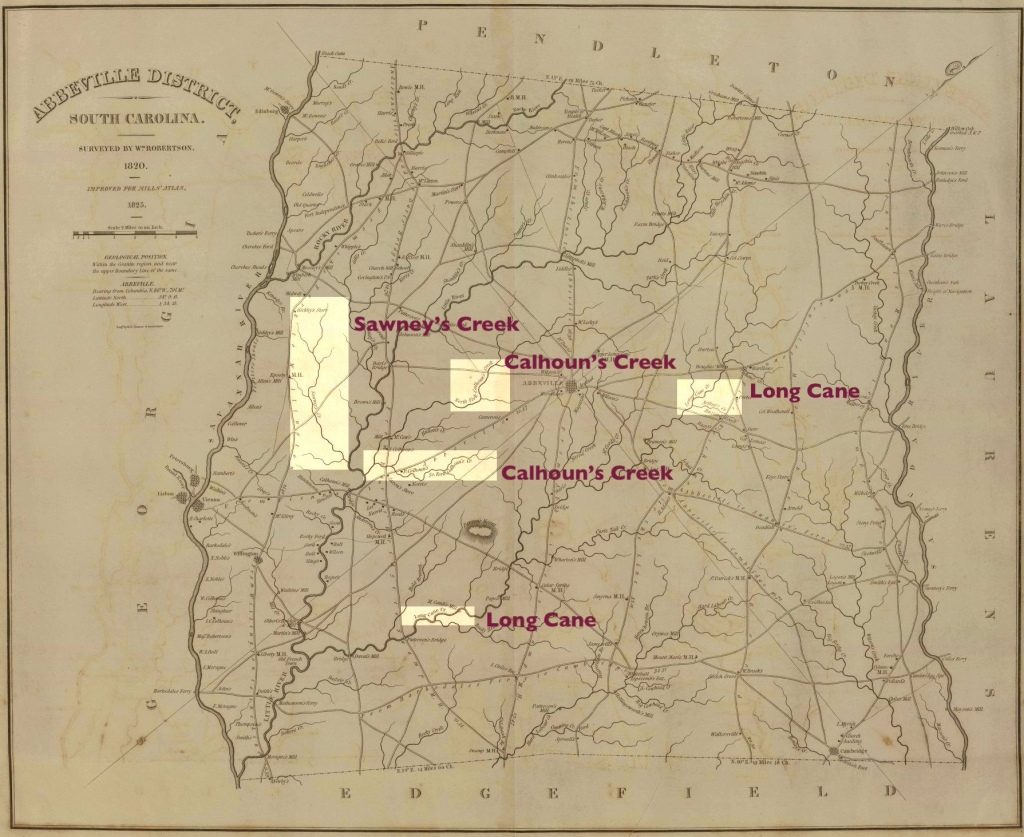
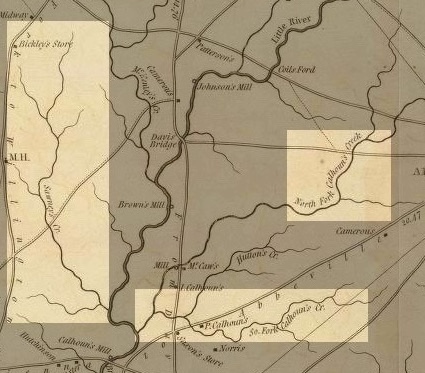
Sawney or Sawney’s Creek runs roughly parallel to the Savannah River from north to south in what is now western McCormick County, South Carolina, which was formed from Abbeville, Edgefield, and Greenwood Counties in 1916. Its course is clearly marked on Robert Mills’ 1825 map of Abbeville District.[9] It empties into Little River just above Calhoun’s Mill, which is on Little River just north of present-day Mt. Carmel. Bob Thompson’s plat maps for the Long Cane settlement, which can be accessed via Google Earth, show Benjamin Green’s tract on the south side of Sawney’s Creek west of Calhoun’s Mill and northwest of Mt. Carmel.[10] The tract is today just on the west side of the intersection of highway 81 and state road S-33-79.
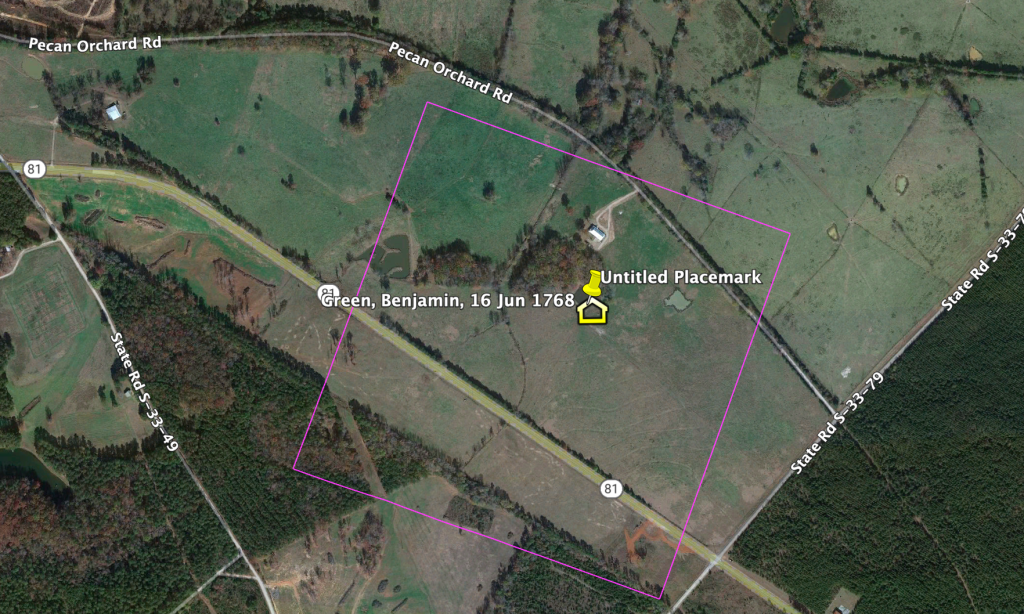
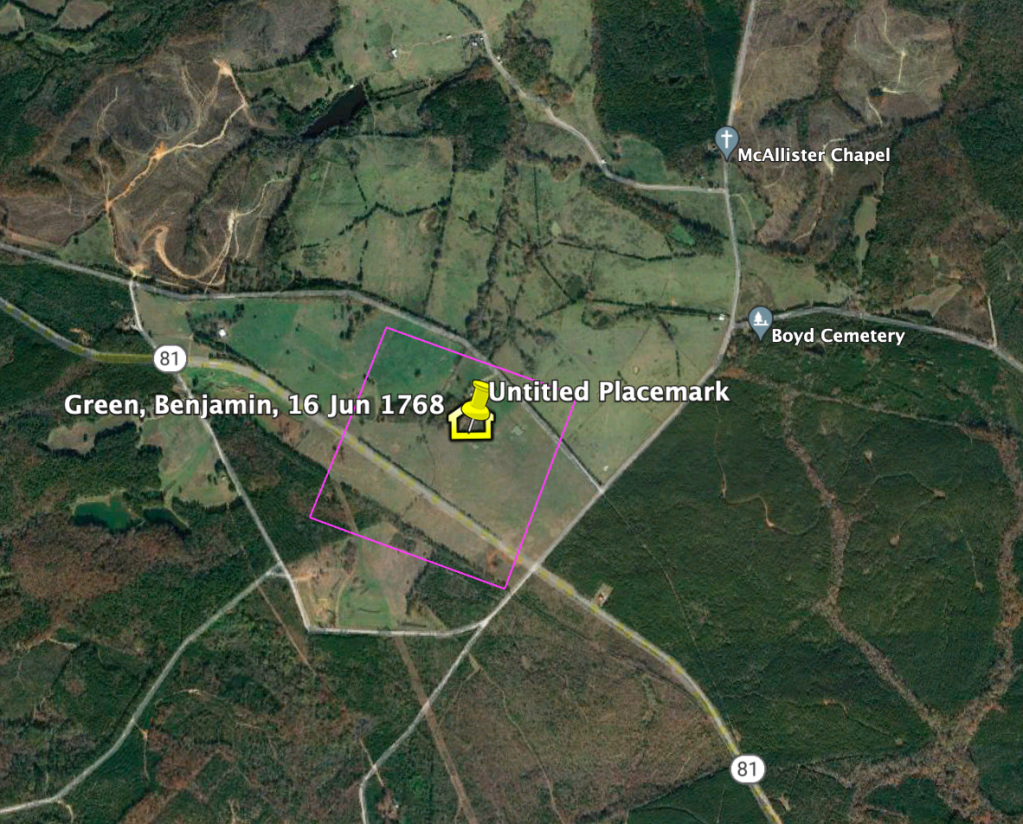
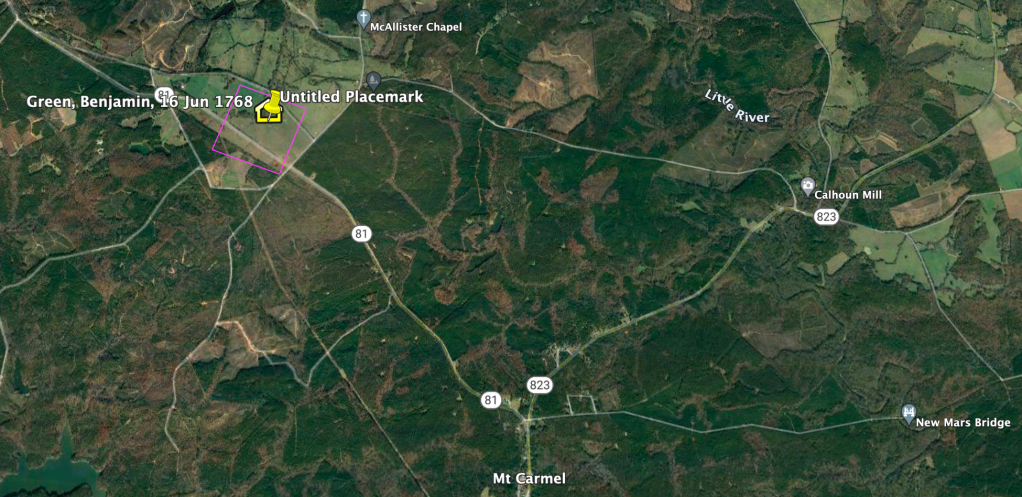

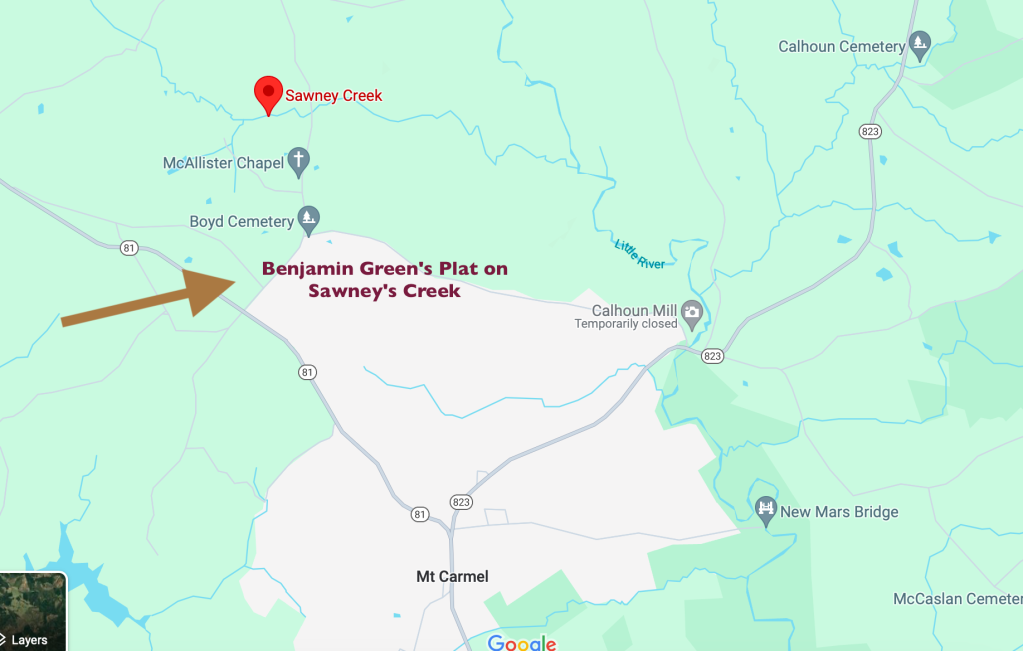

Note a problem we need to face immediately with the June 1768 plat of 150 acres for Benjamin Green on Sawney’s Creek, if we want to propose that he’s the father of the John Green born 21 January 1768 in the Long Cane settlement: as I noted previously, at the time this land was granted to Benjamin Green, South Carolina was granting 100 acres to each adult male head of a household and 50 additional acres to each of that settler’s family members. Benjamin’s grant of 150 acres suggests that his household consisted of himself and one other family member, probably a wife. If he had an infant son at the time he received this grant, why was it not a 200-acre grant?
And, in truth, these 1768 land records are almost the sum total of information I’ve been able to dig up about this Benjamin Green. With early land records destroyed in catastrophic fires, it’s very hard to find information about many of the early settlers of the part of South Carolina that became Abbeville County beyond what’s recorded in state-level plat and grant books. I have found no probate records for Benjamin Green.
Benjamin Green in William Calhoun’s Journal
One document passed down in the Calhoun family of the Long Cane settlement does, however, appear to have information about him, and if I’m reading a transcript of this document correctly, it suggests that Benjamin Green may have been living in this settlement as early as 1760. This document is a journal kept by William Calhoun, a brother of the Patrick Calhoun who platted Benjamin Green’s grant in June 1768, and a brother of Ezekiel Calhoun whose daughter Mary married Samuel Kerr — the parents of Jane Kerr, wife of John Green (1768-1837). In 1904, historian A.S. Salley published a transcript of William Calhoun’s journal.[11] Salley states that the journal he was transcribing was a handwritten book in which William Calhoun entered accounts from a store he operated, notes of fines he had imposed as a justice of the peace, marriage records, and family records. In 1904, this journal was in the keeping of Eliza Calhoun of Washington, D.C. It covers the period 1760-1770 and as Salley notes, it’s to “such contemporary records in private hands that we must turn for genealogical data about Up-Country families” — because early Abbeville records are no longer extant.
Benjamin Green is named several times in William Calhoun’s journal, and I think there’s no reason to doubt that the Benjamin Green whose name appears in this journal is anyone other than the man with the June 1768 plat on Sawney’s Creek of the Long Cane settlement. The store accounts record purchases of a quart and a pint of liquor by Benjn. Green on four separate occasions (two purchases of a quart and two of a pint of liquor).[12] These journal entries seem to have no specific date, but appear to date from the period 1763-6.
In an entry that does appear to have a date, 25 November 1760, a statement is found, “Benjn. Green is dew to me £3.18.8.”[13] And apparently in the same set of accounts dated 25 November 1760 there is another entry showing Benjamin Green owing £1.11.0.[14] On 6 August 1768, William Calhoun noted “Benjn. Green is dew £1.16.9.”[15]



Note that, if I’m reading William Calhoun’s journal as transcribed by Salley correctly, this document would place Benjamin Green in the Long Cane settlement as early as 25 November 1760, a number of years prior to his land grant on Sawney’s Creek. The Calhoun family moved from Augusta (later Wythe) County, Virginia, to the Long Cane area in South Carolina in February 1756, according to a letter John C. Calhoun sent on 21 November 1847 from his Fort Hill plantation at Clemson, South Carolina, to Charles H. Allen of Abbeville.[16] The letter notes that John C. Calhoun’s father Patrick kept a journal that provided details of the family’s move from Virginia to South Carolina.
Notes on Arrival of Calhouns on Long Cane, February 1756
According to Bobby F. Edmonds in his history of the formative years of McCormick County, when the Calhoun family left Virginia following Braddock’s defeat in July 1755, which resulted in attacks by native peoples allied with the French on communities in southwestern Virginia, the Calhouns followed the Great Wagon Road from Virginia to the Waxhaws on the border of the two Carolinas, and were then convinced by a band of hunters to visit the Long Cane area in South Carolina. When they arrived there in February 1756, they first settled east of Long Cane, building a fort less than a mile from the present-day Long Cane ARP church two miles from what’s now Troy, South Carolina. Edmonds says that before the end of the year, the Calhouns then crossed Long Cane and relocated a few miles to the west and north on Little River near present-day Mt. Carmel — that is, very close to where Benjamin Green had a land grant in June 1768.[17] The location of William Calhoun’s store, in other words, is very close to where Benjamin Green had his June 1768 plat on Sawney’s Creek.
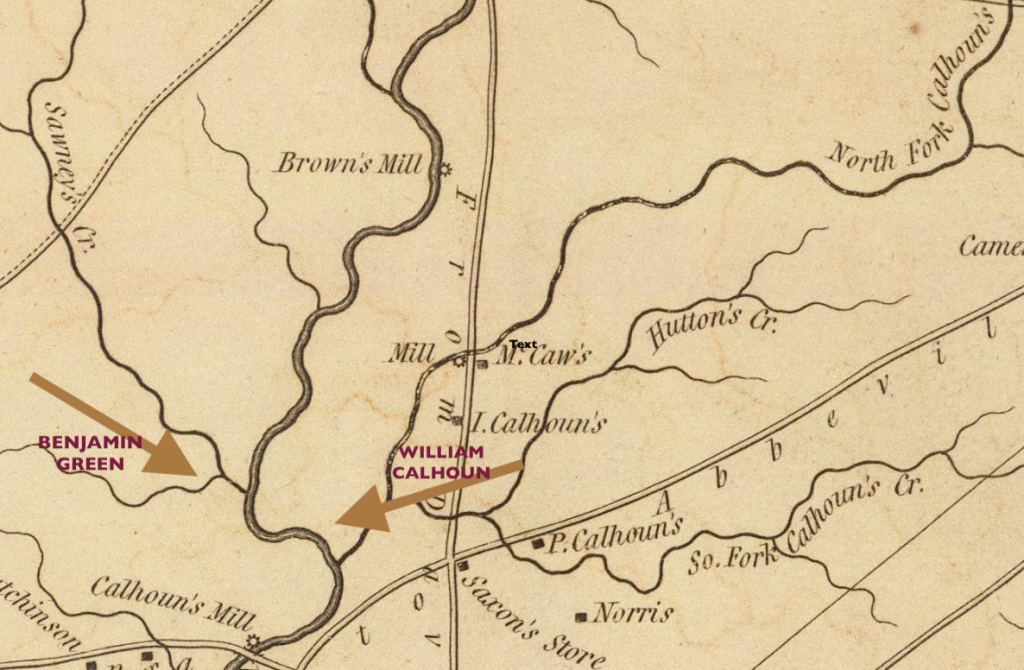
Bobby Edmonds notes that William Calhoun, who had a survey for 400 acres on Long Cane in 18 July 1756, operated a store in the Calhoun settlement, carrying on a lively trade with his neighbors and the Cherokees to the west.[18] In his November 1847 letter to Charles H. Allen, John C. Calhoun states that his uncle William Calhoun settled “in the fork of Calhoun’s Creek and Little River.”[19] Calhoun’s Creek joins Little River from the east side just above where Sawney’s Creek meets Little River on the west side of the river. The juncture of Calhoun’s Creek and Little River is just north of Calhoun’s Mill and Mt. Carmel, and — again — is very close to where Benjamin Green had his June 1768 land plat.
At the time the Calhouns arrived in this vicinity, almost no other white settlers were living in the area, according to John C. Calhoun in his letter to Charles H. Allen. Calhoun states that he is uncertain who immediately followed his Calhoun family to Long Cane, but early neighbors included the Norris family into which his uncle Ezekiel’s widow Jane Ewing Calhoun married when she married Robert Norris following Ezekiel’s death, and a Mercer and Houston family. He writes,
Our family were, however, the pioneers, and my impression is [they] came alone. … There were at the time they made their settlement but two others in the District; one at White Hall, on then Labor Creek, settled by Williamson, a Scotch trader 1754, & the other at Cambridge, then called Ninety Six, settled about the same time by a man by the name of Goudy, also a trader.
William Calhoun’s journal provides a precious snapshot of the earliest settlers in the Long Cane community, then. Most of the names found in the journal, including the entry that appears to date from November 1760 and which includes Benjamin Green’s name, are relatives of William Calhoun, including his brother Patrick, brother-in-law Alexander Noble, son-in-law Isaac Matthews, Andrew Pickens, who married William’s niece Rebecca Calhoun, and members of the Hutton family into which William’s daughter Agnes married. Other early Long Cane families who were also Calhoun connections or whose names appear frequently in records of the Calhoun (and Pickens) family are also named in William Calhoun’s journal, including members of the Miller, Davis, Wilson, and McCleskey (or McCloskey) families.
These families were interconnected from early in their arrival in the Long Cane settlement because, to put the point rather simplistically, there was no one else to connect to. To my way of thinking, that fact supports the conclusion that the Benjamin Green named in William Calhoun’s journal, who is clearly the man of that name with a plat on Sawney’s creek in June 1768, is likely father of the John Green (1768-1837), who married Jane Kerr, a daughter of William Calhoun’s niece Mary Calhoun Kerr, and who managed the Keowee plantation of Mary’s brother John Ewing Colhoun. As I’ll show below, the Benjamin Green Jr. who tutored the children of John Ewing Colhoun and who was, I suspect, a brother of John Green, can be proven to be the son of the older Benjamin Green.
If Benjamin Green was in the Long Cane settlement as early as November 1760, he arrived there not many years after the Calhouns came there and was another early settler of the settlement. Where he came from and what brought him there are questions for which I have yet to find answers. If he was of age by 1760, it seems he’d have been born by or before 1742. This birthdate would place him in the generation of the children of the four Calhoun brothers — James, Ezekiel, William, and Patrick — and of their sister Mary Noble, all of whom came with their mother Catherine Montgomery Calhoun to the Long Cane region in February 1756.
Benjamin Green’s Early Neighbors on Sawney’s Creek —Andrew English, James Keown, George Green
To return to the 16 June 1768 plat for Benjamin Green on Sawney’s Creek: as I state above, the plat record compiled by Patrick Calhoun states that the land surrounding Benjamin was vacant on all sides when the plat was made. On the day following this, Patrick Calhoun made a plat for Andrew English, who had received a warrant for 150 acres on waters of Long Cane in Granville County on 13 February 1768.[20] This tract adjoined Benjamin Green’s tract on the south.
Andrew English arrived in Charleston in February 1768 aboard the Lord Dungannon from Belfast. The South Carolina Council Journal record of his warrant and those of others who came aboard the Lord Dungannon states that Andrew was aged 26 in 1768 and had a wife Jane aged 24 who arrived with him.[21] The grant for this land was made to Andrew English on 1 September 1768.[22]
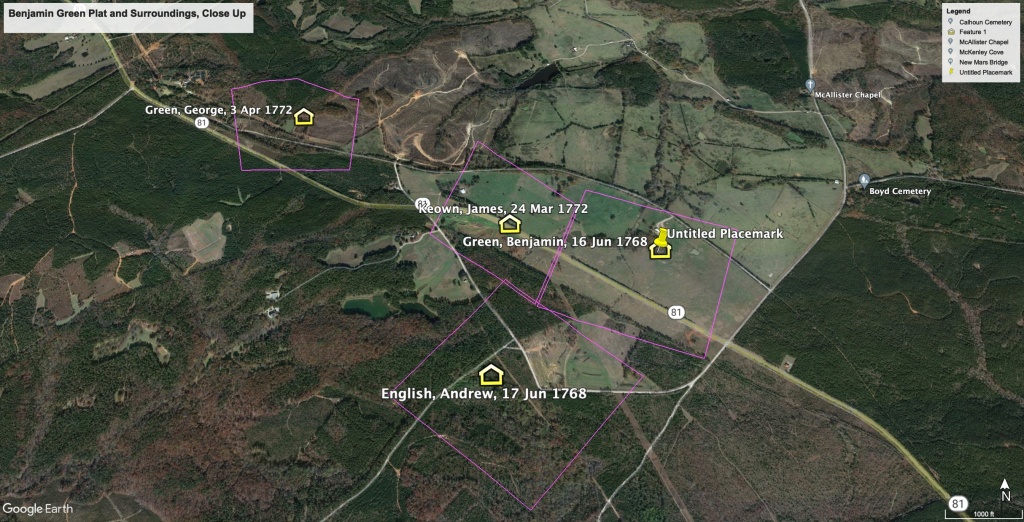
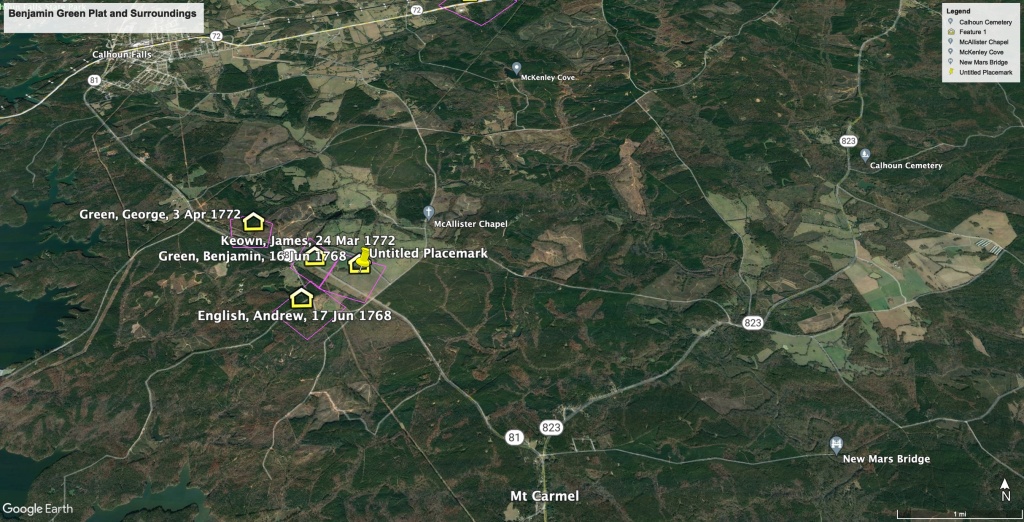
In March and April 1772, two more settlers had plats near Benjamin Green: James Keown and George Green. On 24 March 1772, Patrick Calhoun surveyed 100 acres for James Keown, with the plat stating that the land was between the northwest fork of Long Cane Creek and the Savannah River and bounded southeast in part by Benjamin Green and southwest in part by Andrew English.[23] The plat states that James Keown had a precept for this land on 3 February 1772.
On 23 April 1772, Matthew Long surveyed 100 acres on Sawney’s Creek for George Green.[24] The plat states that Green’s precept for the land was made on 7 January 1772, and that the tract was bounded north by land laid out to Mary Wilson and on other sides by vacant land. The grant for the land was made 21 May 1772.[25] When a memorial for this grant was recorded on 6 August 1772, it stated that the land was now bounded on one side by land owned by Mary Wilson.[26]
By 1772, then, Benjamin Green had neighbors James Keown to the west and Andrew English to the south. Just northwest of Benjamin was George Green. James Keown’s 100 acres were granted to him on 17 March 1775, with the 5 August 1775 memorial stating that the land was bounded southeast by Benjamin Green and southwest by Andrew English.[27] Just to the northwest was George Green’s plat, and a little distance north and east was a tract of land belonging to William Calhoun.
I have no reason to think these men settling around Benjamin Green from 1768-1772 were kin to him, though the proximity of George Green and the shared surname make me wonder about him. Andrew English was clearly an Ulsterman, perhaps close in age to Benjamin Green. Information about James Keown is garbled in such accounts as I can find. A number of published sources suggest he was born about 1744 in County Down, Ireland, so he was likely also Northern Irish and probably close in age to Benjamin Green and Andrew English. When the Lord Dungannon brought Andrew English to Charleston in February 1768, it also brought a Henry and Jane Green (aged 24 and 22) and a James and Elizabeth McKewn (ages 23 and 24). This James McKewn is clearly not James Keown, however. His land grant from the colony was on the Edisto River in Berkeley County. Henry Green’s was on Reedy Creek of the Saluda in Craven County. All Ulster immigrants arriving together on a single ship under the terms of the 1761 bounty act were not usually given grants in the same location, probably because South Carolina’s colonial government feared what might happen if new citizens with close ties and a strong history of pulling together to resist oppressive government were congregated in the same locations.
I have been unable to find much information about George Green. He does not appear on the 1779 census of Ninety-Six District, but was still living in 1784 when Patrick Calhoun surveyed 145 acres for William Hutton between the northwest fork of Long Cane and the Savannah River on 19 November 1784.[28] The plat shows other neighbors Isabella McCleskey, Mary Wilson, and Esther Wilson. I have not found Revolutionary claims for George Green.
Marcia McClure thinks that Isabella McCleskey was the widow of George McCleskey, who had a plat in the Long Cane settlement on 13 September 1767. Marcia also thinks that Isabella may well have been a daughter of Benjamin Green Sr. A 12 October 1784 survey that Patrick Calhoun made for her for 100 acres between the fork of Long Cane Creek and the Savannah River shows the land lying between Benjamin Green Sr. and George Green, with Richard Posey and William Adams owning neighboring land.[29] Isabella’s oldest son was named Benjamin Green McCleskey, according to Marcia, and his birthdate is recorded in a family bible as 7 September 1777.
The 11 January 1809 will of Sarah Green of Abbeville County names sons George, James, and Thomas Green, and daughters Frances Cullens, Elizabeth Sims, and Nancy Shirley.[30] I tend to think this George Green would have been younger than the man of that name who settled on Sawney’s Creek in April 1772. Nor is the George Green of the 1772 plat record the George Green whose parents were Robert Green and Catherine Livingston, Robert being a son of the John Green who had the November 1766 plat on Long Cane. That George Green(e) appears in most records with the middle name Livingston.
Records of Benjamin Green After 1779 — Revolutionary Audited Account, Information in Land Plats
Benjamin Green appears as head of a household on the 1779 census of Ninety-Six District, South Carolina, and South Carolina Revolutionary records show Benjamin Green being issued a pay indent in 1785 for £23.6.¾ for militia duty in 1779-1780 under Colonel Robert Anderson.[31] The audited account file has a receipt dated 22 April 1785 showing Moses Trimble signing receipt on behalf of Benjamin Green for payment of this amount. Also in the account file is a note signed by Benjamin Green in Abbeville County on 30 July 1785 giving permission for Moses Trimble to collect his payment, with Robert Anderson also signing to certify that Benjamin Green had signed this permission note. Benjamin Green signed the permission note by mark, and for this reason I do not think that this service record belongs to the younger Benjamin Green who was the tutor of John Ewing Colhoun’s children and likely the son of the older Benjamin.



As did the Calhouns, the Trimble family came to the Long Cane settlement from Augusta County, Virginia, where the Trimble family was living as early as 1741, after having proved its importation from Northern Ireland at Orange County, Virginia, court on 22 May 1740. The family had come to Philadelphia in 1733 or 1734 and then moved to western Virginia. Walter Trimble moved to the Long Cane settlement between 20 May 1765 when he sold his land in Virginia and 1 December 1769, when he had a grant of 200 acres on the northwest fork of Long Cane in Granville County bounded on the northwest by Samuel Kerr.[32]
As previous postings note (here and here), Robert Anderson (1741-1813), for whom Anderson County, South Carolina, is named appears as a neighbor of John Green (1768-1837) when John first bought land in Pendleton District in January 1793. And as the second of the two postings I’ve just linked states, after John Ewing Colhoun, uncle of John Green’s wife Jane Kerr, made his will on 20 May 1802, he added a codicil on 21 October 1802 making his nephew Ezekiel Pickens an executor in addition to previously named executors, and this codicil was witnessed by John Simpson Jr., Benjamin Green Jr., and Robert Anderson. Robert Anderson was born in Augusta County, Virginia, and was closely associated with Andrew Pickens, who married John Ewing Colhoun’s sister Rebecca. As a preceding posting notes, John Simpson was the husband of Andrew and Rebecca Calhoun Pickens’ daughter Ann Pickens.
Benjamin Green Jr. Begins Appearing in Abbeville and Pendleton District, Records
By 11 October 1784 when Patrick Calhoun platted 192 acres in Ninety-Six District for Benjamin Green Jr. adjoining Benjamin Sr. and others, the younger Benjamin seems to have come of age and Abbeville records begin distinguishing between Benjamin Sr. and Jr.[33] The plat shows Joseph Coffer (Cofer in other documents) as a neighbor, and on the same day, Patrick Calhoun surveyed 250 acres for Coffer between the northwest fork of Long Cane and the Savannah River, with the plat showing that the tract joined Benjamin Green Jr. and others.[34]
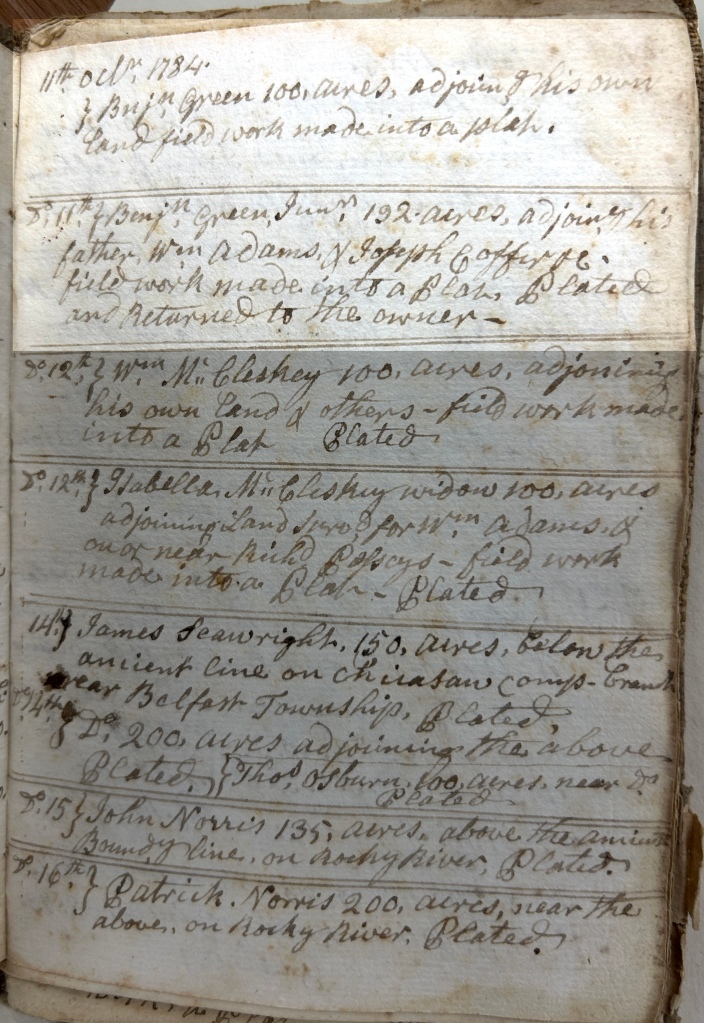

In a little survey book he kept from 1784 to 1792, Patrick Calhoun recorded a valuable piece of information about Benjamin Green Sr. and Jr. as he surveyed their adjoining tracts of land on 11 October 1784. He stated that the 192 acres he surveyed for Benjamin Green Jr. adjoined the tract he had just surveyed for “his father,” i.e., Benjamin Green Sr. The survey book places the two surveys together, with Benjamin Jr.’s survey notes following those of his father. The notes also state that the 100 acres Patrick Calhoun surveyed for Benjamin Sr. on 11 October 1784 adjoined Benjamin’s own land. This document proves that the younger Benjamin Green, who was the tutor for John Ewing Colhoun’s children up to John E. Colhoun’s death in 1802 and who was, I am persuaded, a brother of John Green (who married Jane Kerr), was son of the older Benjamin Green.
Note, by the way, that the page of Patrick Calhoun’s survey book on which he noted his 11 October 1784 surveys for Benjamin Green Sr. and Jr. follows those two surveys with surveys Patrick did the following day for William McClesky and the widow Isabella McCleskey who may be another child of Benjamin Green.

On 19 November 1784, Benjamin Green Sr. had another plat for 300 acres on Sawney’s Creek.[35] Patrick Calhoun’s plat, which spells Sawney’s Creek as Sanes Creek, shows Benjamin Green Jr. with land adjoining on the south, William Adams to the southwest and James Keown to the west, and Wilson and Cappock to the north.
A plat made for James Keown by Patrick Calhoun on 6 January 1785 for 158 acres on waters of Sawney’s Creek identifies Wilson and Cappock as John Cappock and Mary Wilson, and shows Benjamin Green Sr. to the south.[36] William McCleskey is also named as a neighbor.

When Patrick Calhoun made a plat for 250 acres for James Noble, son of John Noble and Mary Calhoun, on Sawney’s Creek on 20 June 1785, the plat showed Benjamin Green Sr. to the east and to the west John Ewing Colhoun with John Steadman, with Samuel Brown next to them and with John Cappock on the north and land surveyed for James Thompson to the south.[37]
These plats of the latter half of the 1780s show people based in the Calhoun settlement to the east now moving westward or acquiring land to the west towards the Savannah River. John Steadman was the brother-in-law of John Ewing Colhoun: he married Jean Calhoun, daughter of Ezekiel Calhoun and a sister of John Ewing Colhoun. The John Ewing Calhoun Papers in the South Caroliniana library at University of South Carolina in Columbia have an inventory of John Steadman’s goods dated 23 April 1793 and compiled by Samuel Brown.
Note something important that the June 1785 plat for James Noble tells us: not long prior to the marriage of John Green (1768-1837) and Jane Kerr, which seems to have occurred about 1788, Jane’s uncles John Ewing Colhoun and John Steadman had acquired land close to the land of Benjamin Green Sr., with their first cousin James Noble joining them with land surveyed in June 1785 on Sawney’s Creek joining Benjamin Green’s land.
The 1790 federal census for Abbeville County shows Benjamin Green Sr. with a household containing two white males 16+, one white male -16, and three females.[38] The census lists Benjamin as Benjamin Green Sr. His given name is smudged on the census page. He is enumerated between William Hutton and William Adams, and is four houses away from Patrick Calhoun, Esq. On the same census page, Jane Kerr’s mother Mary Calhoun Kerr appears. Other names mentioned in documents cited above — John Steadman, Isabel McCleskey, William McCleskey, James Noble, e.g. — are also found on this census page.
As a previous posting notes, by 1790, John Green (1768-1837) with wife Jane Kerr had settled in Pendleton District, where it appears they began managing the Keowee plantation that Jane’s uncle John Ewing Colhoun had established shortly before they married. In addition to Benjamin Sr., the other older male in Benjamin Green’s household in Abbeville County in 1790 may well be Benjamin Green Jr., who began appearing as the tutor of John Ewing Colhoun’s children not long down the road.
On 10 May 1791, Benjamin Green had a survey for 443½ acres in Pendleton District on Little Generostee Creek. The plat for this land was recorded 16 August 1794.[39] The grant for this tract was made 2 September 1793.[40] Though the plat record does not state that this is Benjamin Green Jr., when he sold this land on 21 February 1797 to James Alfer of Chatham County, Georgia, the deed states that Benjamin Green Jr. of Abbeville County was selling the land.[41] This land on the Little Generostee was in the far southwest of Pendleton District on the Abbeville County border and bordered by the Savannah.
The very next plat in the plat book after Benjamin Green’s plat for this Little Generostee land is John Green’s plat for his initial acquisition of land in Pendleton District, 838 acres on the Keowee. In my view, what we see here are two brothers from Abbeville County, both having come of age not long prior to 1790, beginning to acquire land in Pendleton District by the early 1790s.
Benjamin Green Sr. Appears to Die by 1801 or 1802
I find no Benjamin Green enumerated on the 1800 federal census in either Abbeville or Pendleton County/District, South Carolina. By 2 November 1801, when he witnessed a deed of James Milwee to John Ewing Colhoun and another deed by John Ewing Colhoun to someone whose name I cannot make out in the digitized copy of the original, Benjamin Green, both in Pendleton District, Benjamin Green Jr. begins appearing with no Jr. designation, and I find no more mention of Benjamin Green Sr., so I’m inclined to think the older Benjamin died by November 1801.[42] However, as I noted previously, Benjamin Green witnessed a 21 October 1802 codicil to the will of John Ewing Colhoun, signing as Benjamin Green Jr. So this may mean that the older Benjamin died after May 1802, probably in Abbeville County.
The big puzzle I’m left with here, in addition to the question whether Benjamin Green Sr. was the father of my John Green (1768-1837): Where was Benjamin prior to his arrival in the Long Cane settlement. Given his proximity to the Calhouns and the connections of the two men I think may well be his sons, John and Benjamin, to the Calhoun family, you’d think Benjamin Green Sr. might appear in some of the many records of the Calhoun family prior to its arrival in the Long Cane area in February 1756.
But I can find neither hide nor hair of Benjamin Green in the places the Calhouns lived before they arrived on the Long Cane. Ditto for the Kerr family of John Green’s wife Jane Kerr, and for the Pickens family of Jane’s grandmother Margaret Pickens Kerr: like the Calhouns, these were Ulster Scots families that came from Northern Ireland to Pennsylvania, then moved down into western Virginia before arriving on the Long Cane in the South Carolina upcountry and settling all near each other. I find no mention of a Benjamin Green in the records of either of these families before they settled in the Long Cane settlement.
So the search continues — and I may well be far off-track with the unproven, but to my way of thinking, plausible deductions I’m making in the material I discuss above…. In my next posting, I’ll share such additional information as I have regarding Benjamin Green Jr., the tutor of John Ewing Colhoun’s children who, as we saw above, is proven by Patrick Calhoun’s 1784-1792 survey book to be a son of the older Benjamin.
[1] South Carolina Colonial Plat Bk. 10, p. 74.
[2] South Carolina Council Journal, 4 November 1766, pp. 861-7.
[3] South Carolina Memorials Bk. 9, p. 333.
[4] South Carolina Department of Archives and History, “Granting of Land in Colonial South Carolina,” South Carolina Historical Magazine 77,3 (July 1976), p. 212.
[5] I understand that one set of DNA findings is a slim basis on which to make sound deductions about an ancestral line, and that the ideal is to test more male descendants of John Green (1768-1837). The one other known descendant I invited to have Y-DNA work done has adamantly refused, stating that he knows John Green was the son of the John Green with a November 1766 plat on Long Cane, and he doesn’t need DNA work to convince him of this.
[6] South Carolina Colonial Plat Bk. 9, p. 293.
[7] South Carolina Royal Grants Bk. 18, p. 104.
[8] South Carolina Memorials Bk. 8, p. 404.
[9] Robert Mills, Map of Abbeville District, South Carolina (Philadelphia: H.S. Tanner, 1825), available digitally at Library of Congress Geography and Maps Division website.
[10] Several years back, researcher Bob Thompson produced a very valuable resource for those researching early families of the Long Cane settlement: this was a searchable online set of plat maps for the early settlers, using the plats drawn by surveyors and on file (and available digitally) at the South Carolina Department of Archives and History. Bob Thompson’s plat maps allow one to see the interrelation between the plat for one early settler and those of other early settlers. These used to be accessible through an internet url. I now find I can access these plat maps only via Google Earth, and I unfortunately don’t know how to share an access point to this material here.
[11] A.S. Salley, “Journal of William Calhoun,” Publications of Southern Historical Association 8,3 (May 1904), pp. 179-195.
[12] These journal entries are transcribed on pp. 185-6 and 188 of ibid.
[13] P. 188 of ibid.
[14] P. 189 of ibid.
[15] P. 190 of ibid.
[16] The original is in the John Caldwell Calhoun Papers at the South Caroliniana Library of the University of South Carolina, Columbia, with the title “Account of the Settlement of the Calhoun Family in South Carolina.” The letter is transcribed in “John C. Calhoun to Charles H. Allen, November 21, 1847,” Gulf States Historical Magazine 1,6 (May 1903), pp. 439-441. See also John H. Logan, A History of the Upper Country of South Carolina, vol. 2 (Charleston: Courtenay, 1859); John S. Jenkins, The Life of John Caldwell Calhoun (New York: Hurst & Co., 1852), pp. 19-20; and Mary B. Kegley, Early Adventurers on the Western Waters, vol. 3, pt. 2 (Marceline, Missouri: Walsworth, 1995), pp. 597-8.
[17] Bobby F. Edmonds, The Making of McCormick County (McCormick, South Carolina: Cedar Hill, 1999), p. 13.
[18] Ibid., p. 15. See also A.S. Salley, “The Calhoun Family of South Carolina,” South Carolina Historical and Genealogical Magazine 7 (1906), pp. 81-98, reproduced in Gene Waddell, ed., South Carolina Genealogies: Articles from South Carolina Historical and Genealogical Magazine, vol. 1 (Spartanburg, South Carolina: Reprint Co., 1983), pp. 257-8; and H.T. Cook, The Hard Labor Section (Cook, 1923), pp. 6-7.
[19] See supra, n. 16.
[20] South Carolina Colonial Plat Bk. 15, p. 44.
[21] See Janie Revill, A Compilation of the Original Lists of Protestant Immigrants to South Carolina, 1763-1773 (Columbia, South Carolina: State, 1939), p. 106, transcribing South Carolina Council Journal minutes for 13 February 1768, vol. 34, pp. 53-51.
[22] South Carolina Royal Grants, Bk. 17, p. 572.
[23] South Carolina Colonial Plat Bk. 17, p. 432.
[24] Ibid., vol. 16, p. 200.
[25] South Carolina Royal Grants, Bk. 25, p. 546.
[26] South Carolina Memorial Bk. 11, p. 325.
[27] Ibid., Bk. 2, p. 279.
[28] South Carolina Plats, Charleston Series Bk. 19, p. 291.
[29] Ibid., Bk. 7, p. 234.
[30] Abbeville County, South Carolina, Estate Record Bk. 1, p. 371; estate packet box 39, pkg. 853.
[31] 1779 Census Ninety-Six District, South Carolina, abstracted and indexed by Paul R. Garrett at the USGenweb Census Project; and Account Audited of Claims Growing out of the American Revolution, file 3059, available digitally at the website of South Carolina Department of Archives and History.
[32] See David B. Trimble, American Beginnings (Trimble, San Antonio, 1974), p. 152; and Eugene Earl Trimble, Trimble Families, a Partial Listing of Some Colonial Families (Trimble, Kensington, Maryland, 1986), pp. 45, 53, citing Augusta County, Virginia, Deed Bk. 12, p. 422.
[33] South Carolina Plats, Charleston Series Bk. 11, p. 356.
[34] Ibid., Bk. 9, p. 391.
[35] Ibid., Bk. 1, p. 194.
[36] Ibid., Bk. 18, p. 173.
[37] Ibid., Bk. 15, p. 299.
[38] 1790 federal census, Abbeville County, South Carolina, p. 452.
[39] South Carolina Land Plats Bk. 29Q, p. 298.
[40] South Carolina Land Grants Bk. 32, p. 243.
[41] Pendleton District, South Carolina, Deed Bk. C-D, p. 316.
[42] Ibid., Deed Bk. F, pp. 495-6, Bk. G, pp. 94-95.
Ran across this very informative article while searching for my own Alexander/ English family in the Long Canes Settlement. I do have ideas about where they might have come from after leaving Virginia and before coming to Long Canes Settlement.Please contact me for information you might find helpful. While I go back and review information I have about Kerr family.
LikeLike
Thank you very much for your message and for sharing your email address. I’ll email you and hope we can be in touch to share information about the possible background of the Green family and interrelated families in the Long Canes settlement.
LikeLike